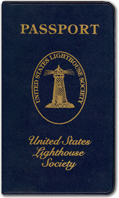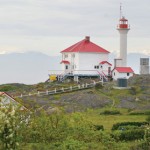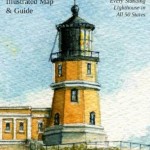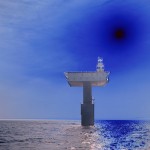By Jerome Aning
Philippine Daily Inquirer
First Posted 02:05:00 01/09/2011
MANILA, Philippines—The future of the “lonely sentinels of the sea”—as architectural historian Manuel Maximo Noche Lopez del Castillo calls the network of 19th-century lighthouses in the Philippines—is looking brighter with the much-improved finances of the Philippine Coast Guard (PCG).

With an increased budget this year, the PCG said it can now intensify its lighthouse repair program and thereby promote the safe navigation of ships and fishing boats in the country’s numerous waterways.
This year, the agency will be upgrading the country’s 513 operating lighthouses and reviving about 43 others that are not operational, said Adm. Wilfredo Tamayo, the PCG commandant.
For years, because of the Coast Guard’s perennial lack of funds and personnel, the lighthouses have rapidly deteriorated.
In a report, Tamayo said that with the repairs and upgrades last year, the overall operational efficiency of lighthouses improved—from 85 percent during the first half of the year to 92 percent in the second semester.
This year, he said the Coast Guard aims to improve the overall lighthouse operational efficiency to at least 95 percent and with the agency’s increased 2011 budget, it has every chance of achieving this.
The Coast Guard’s budget was increased from P2 billion in 2010 to P3 billion this year. The agency, however, has many other priorities such as the acquisition of new vessels and aircraft for patrol and rescue missions and the recruitment of 1,000 new personnel in the next two years.
Most of the lighthouses, usually charged by solar power, are not manned 24/7. While many have timers and automatically turn on at night or when the skies turn dark, others have to be manually turned on by a PCG civilian employee.
Tourism potential
These days, the Coast Guard has hit upon another way to keep the lighthouses burning brightly for years to come.
With the increasing recognition of heritage as a solid basis for a tourism industry, a network of restored and preserved historic lighthouses would be sure to bring in the tourists, the PCG argues.
“Several of our lighthouses are centuries-old, dating from the Spanish and American times, and they continue to attract local and foreign tourists. They are considered a national treasure and part of our heritage,” said Lt. Cmdr. Armand Balilo, the PCG spokesperson and deputy chief of staff for community relations.
“Many lighthouses are located in scenic spots. Most are on top of hills and along beaches. They give beautiful views,” Balilo said.
The major ones
One of Balilo’s favorite lighthouses is the Capones Island Lighthouse on Capones Grande Island off the coast of San Antonio, Zambales. The lighthouse, which serves as a beacon to ships entering Subic Bay, was first lit in 1890. The tower has been renovated through the years but the keeper’s house and other buildings in the station have severely deteriorated.
Among the most beautiful lighthouses in northern Luzon are the ones at Cape Bojeador in Burgos, Ilocos Norte and Cape Engaño in Sta. Ana, Cagayan.
The lighthouse on Batanes’ Sabtang Island is a popular tourist attraction in a province that has become the latest must-see destination.
The Coast Guard proposes to turn over the administration of lighthouses to local government units and public and private partners, hoping to generate income from tours, film shoots or advertisements featuring the most picturesque of the country’s lighthouses.
“We will still be in charge of the operation of the lighthouse. But we can have an agreement whereby the LGUs and public or private partners may collect fees, part of which will be used in the maintenance and preservation of the lighthouse or even the hiring of a civilian employee to look after it,” Balilo said in an interview.
Stone and brick structures
A typical lighthouse, or light station, in the Philippines is composed of an elevated cylindrical structure, usually made of metal, with a bright lamp on top with mirrors and lenses to magnify illumination.
The older lighthouses are constructed of stone or brick. They usually retain the Spanish word for lighthouse (faro) in their names. An example of this is the Faro de Punta Malabrigo in Lobo, Batangas.
The Malabrigo lighthouse, constructed during the late 1890s in the twilight of the Spanish colonial regime, was used as the locale for an indie film in 2007. Unfortunately, the film crew, who were largely unsupervised, caused some structural damage to the place. The PCG has now cordoned off the lighthouse and visitors are not allowed to see it unless they have prior permits.
Balilo said the location of the lighthouses inadvertently contributes to the destruction, deliberate or otherwise, of the structures.
“Most lighthouses are located along distant shores, on points and capes, and at harbor entrances, far away from communities. They are subject to wear and tear from the elements such as the wind, salt spray and erosion. Their isolated location also makes them vulnerable to vandalism,” he said.
Many of the 43 nonoperational lighthouses have had their equipment stolen, while some have been damaged by natural disasters, according to Balilo.
Inspection teams
The PCG’s Maritime Safety Services Command (MSSC) periodically deploys field maintenance and inspection teams around the country to undertake repairs to the system of lighthouses.
The MSSC itself is a busy Coast Guard division involved in maritime safety and environment regulation enforcement, inter-island communications as well as salvage operations, management of buoys, and anti oil spill operations.
According to PCG statistics, Central and Eastern Visayas have the most number of lighthouses, with 127, followed by Southern Tagalog, 101; and Northern Mindanao, 56. Western Visayas has the most number of nonoperating lighthouses, with nine, followed by northern Luzon and Palawan, with eight and seven, respectively.
Victorian design
Apart from serving as signal stations and beacons for oceangoing ships through the centuries, a few lighthouses of the Spanish period, particularly those in the Visayas and Mindanao, served as watchtowers against pirates and slave traders.
The Paris-based International Council on Monument and Sites (Icomos) recognizes the heritage value of the Philippines’ Spanish-era lighthouses, which are mainly of Victorian design.
Constructed by Spain’s renowned Inteligencia del Cuerpo de Ingenieros de Caminos, Canales y Puertos (or the Corps of Engineers for Roads, Canals and Ports), the lighthouses were built to protect burgeoning maritime trade in late 19th-century Philippines.
“These structures located in the most beautiful and spectacular sites, lonely isolated islets, cliffs, barren rock outcrops, bluffs, capes and points, are testament to the commitment the Spanish colonial government had in the Philippines to modernize it and make it competitive at the dawn of the 20th century,” Noche wrote in an article in the Icomos website.
First lighthouse
According to Noche, the first lighthouse in the country was erected on the mouth of the Pasig River to protect the Mexico-bound galleons.
The Spaniards also made lighthouses of fabricated metal. Called “tourelles,” they were manufactured in France and assembled on site. A few tourelles still stand on the coasts of or isles off Iloilo, Cebu, Sorsogon and La Union.
Major lighthouses have pavilions and verandahs made of wood and metal where lighthouse personnel and visitors can view the surroundings.
It was during the American colonial and Commonwealth periods that permanent quarters for lighthouse personnel were built.
“The Spanish colonial lighthouses built over 100 years ago still serve their master well. Guiding ships to their ports of call, these structures, stripped of their dignity, still stand proud in their lonely windswept locations. Yet even with time and the elements acting against them, the beauty that the Spanish engineers erected on our soil cannot be erased.
Inheritors of patrimony
“It is time that we, the inheritors of this patrimony do what we can to ensure its survival for the next 100 years. For these lights not only lit the souls and imaginations of those who chanced upon them they also guided a nation to progress,” wrote Noche.
Balilo agrees, saying that while the PCG does not have enough funds to convert the country’s lighthouses into sophisticated ones, the lanterns and the towers are still important guideposts for travelers in an archipelago like the Philippines.
In other countries, some lighthouses are virtual robots and have GPS (global positioning satellite), cameras and radio receivers, he noted.
“The lighthouses still serve our local fishermen and boat travelers who do not venture far from the shore. When GPS and radios fail and visibility is poor during storms and rough seas, it is always a comfort to get a view of light coming from a lighthouse, knowing that land and safety are near,” Balilo said.
 Lighthouse in Vieste, Italy (Roby Ferrari)
Lighthouse in Vieste, Italy (Roby Ferrari)



